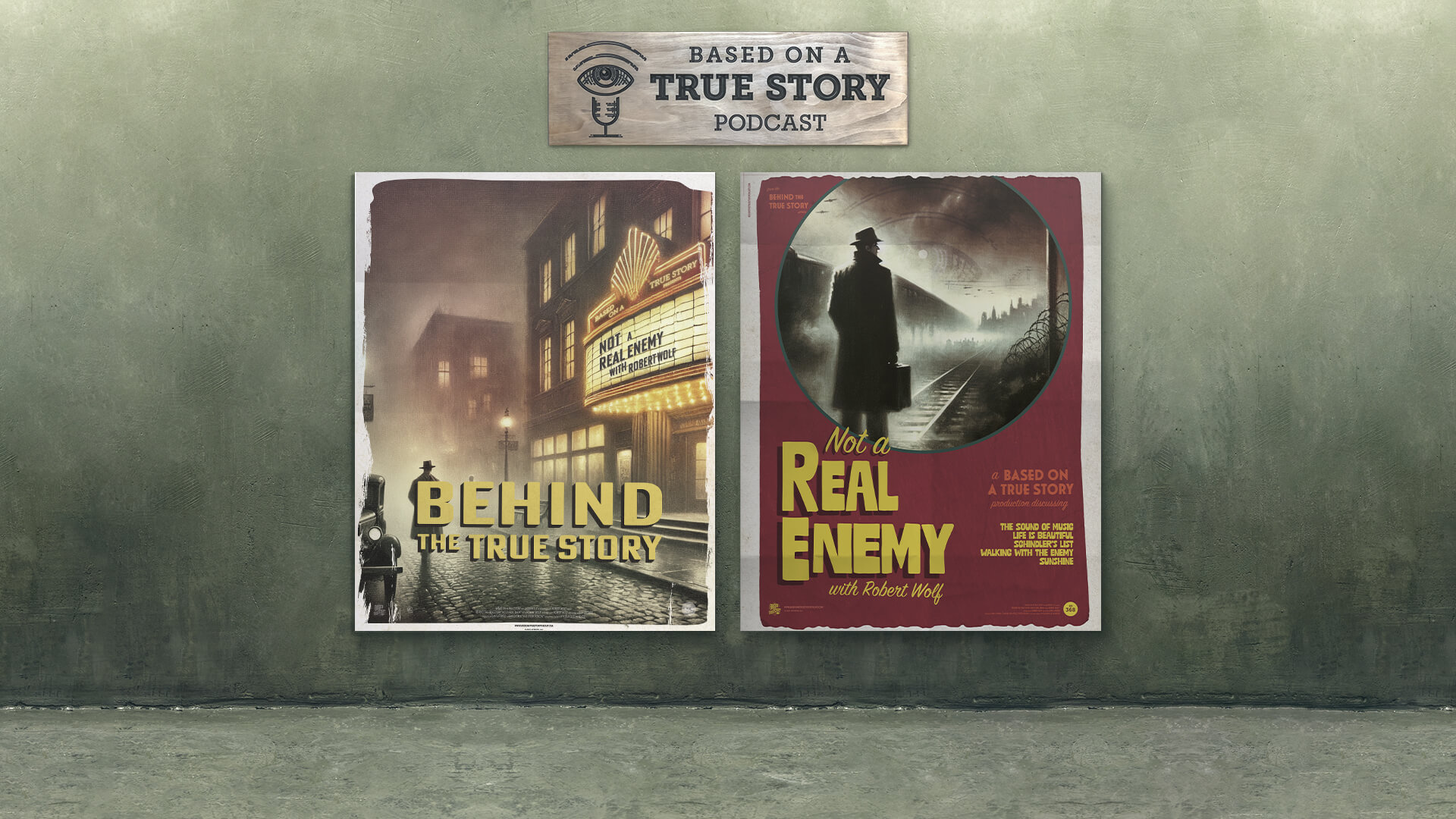On this episode, we’ll learn about historical events that happened this week in history as they were depicted in The Conspirator, Pearl Harbor and The Red Baron.
Did you enjoy this episode? Help support the next one!
Disclaimer: Dan LeFebvre and/or Based on a True Story may earn commissions from qualifying purchases through our links on this page.
Transcript
Note: This transcript is automatically generated. There will be mistakes, so please don’t use them for quotes. It is provided for reference use to find things better in the audio.
April 17, 1865. Washington, D.C.
We’re in the middle of a movie montage.
Newspaper headlines are crossing the screen.
One headline is dated Saturday, April 15th and says, “President Lincoln Murdered” and the “Nation in shock.”
Another shows photographs of three men and says there’s a $100,000 reward for the murderer. That paper is dated April 20th, 1865. The next paper is hard to see the date on, but it mentions Stanton orders troops to close down Washington, D.C.
Then, we see soldiers arresting a man hiding in a building. In another shot, they’re arresting someone on a train. Another man is arrested while he’s sleeping. Then, we see them arresting some women and putting them in the back of a barred wagon. The newspaper that floats above this screen tells us the “Surratt Boarding House Raided.”
This montage comes from the 2010 movie The Conspirator and although it doesn’t focus too much on the dates between the April 15th and April 20th newspaper headlines that we see, it was this week in history on April 17th, 1865 that Mary Surratt was arrested as a conspirator in the assassination of President Abraham Lincoln.
Because we only see a montage of newspapers, we don’t see much of the actual event.
What happened was that Mary’s oldest son, John, was a known associate to many former Confederates during the Civil War who were now suspected in the assassination conspiracy: David Herold, Lewis Powell and John Wilkes Booth, to name a few.
So, on the evening of April 17th, investigators were at Surratt’s home in D.C. to interview her about the assassination. While they were there, Lewis Powell happened to show up, knocking on the door. He was carrying a pick-axe, which seemed rather suspicious.
When asked about it, Powell told the investigators he had been hired by Mary Surratt to dig a gutter. When they asked Mary to confirm this, she said she didn’t know who he was and she certainly didn’t hire him to dig a gutter.
That, coupled with some evidence that included a photo of John Wilkes Booth, was enough for the investigators to arrest Mary Surratt. Some other conspirators were arrested this week in history, too, with Samuel Arnold also being arrested on April 17th, although some others weren’t caught until next week, like John Wilkes Booth and David Herold were found in a barn on April 26th.
But if you want to watch the arrests and subsequent trial of Mary Surratt, the montage starts at about 14 minutes into the 2010 movie called The Conspirator.
And if you want to learn more about the true story, we covered that on episode #175 of Based on a True Story.
April 18, 1942. Tokyo.
The camera pans up from the water to the aircraft carrier.
On the deck are a bunch of airplanes waiting to take off. But, these aren’t the kind of airplanes you’d expect to see on an aircraft carrier. They’re B-25s: Bombers. Inside the carrier, the radar operator calls out a warning. Japanese patrol boats are only 400 yards away and closing! The captain gives the order to go to general quarters. They have to sink the Japanese before they give away the Americans’ position.
A klaxon alarm goes off as sailors run this way and that on the ship.
One of the men inside the bridge says they were supposed to launch 400 miles away, how far are we now? 624 miles is the reply.
With the new numbers, one of the men starts doing a quick calculation. Then, he looks up at Alec Baldwin’s version of Colonel Jimmy Doolittle. “I don’t know,” he tells Doolittle. He says he just doesn’t know if the planes can carry enough fuel to make it to China.
A moment later, Doolittle makes his decision: Now. We launch now!
In the next shot, we see a flurry of men. Doolittle orders the planes to be stripped of anything unnecessary to make room for fuel. It’s a fine balance of having enough fuel to make up the extra miles, but not so much that the planes will be too heavy to get off the carrier.
More gas is added to each plane as guns are removed to lighten up the planes.
The two pilots the movie focuses on mostly are Ben Affleck’s character, Rafe McCawley and Josh Hartnett’s character, Danny Walker. Then, of course, there’s Colonel Doolittle, who is also flying one of the planes.
One by one, the B-25s start taking off. There were a few close calls, but everyone gets away okay. As the last two take off, we can see in a single shot there are 16 B-25s in the skies now.
The next shot follows the bombers are they fly over land.
Rafe calls back to the other men on the plane, identifying the land as Japan. It’s time to man your guns!
Over an industrial part of town, the bombers open their doors and start dropping bombs. Explosions rip through the buildings below as we can see people running away from the flames and glass flying everywhere.
From below, the sound of an air raid siren can be heard. Japanese defenders start shooting back with their anti-aircraft guns. The B-25s are trying to dodge the flack, but it’s everywhere. Some of the planes get hit, leaving holes in the side as air starts whipping around inside.
Back in the United States, a general delivers an update to President Roosevelt. He says that Doolittle had to advance the plan by 12 hours. They won’t have enough fuel to return to the mainland.
Back with the planes, Colonel Doolittle breaks radio silence. He tells the men he’s sorry. You’re all brave souls, he says, but we’re on our own.
This event comes from the 2001 movie called Pearl Harbor and it depicts something that happened this week in history: The bombing of Tokyo by what we now know as the Doolittle Raid.
The movie was correct to suggest the bombers weren’t trying to return to the carriers to land. They learned that in the training for the mission, which began in January of 1942. The reason was simply because landing a bomber on a carrier was much more difficult than taking off.
So, the plan was to drop their bombs and then head to China.
The movie was also correct to show them stripping the planes down by removing guns and adding an extra gas tank. They really did paint broomsticks in the hopes it’d deter Japanese fighters from attacking the bombers, but it’s not like they did it mere minutes before they were going to launch.
With that said, though, the plan was forced to happen ahead of time. That was because a little after 3:00 AM on April 18th, a Japanese boat was detected. The American task force tried to evade the Japanese ship, only to find yet another one on radar. At about 7:30 AM, another Japanese patrol boat was spotted about 11 miles or 18 kilometers away. The movie was also correct to show 16 B-25s.
The movie was wrong to suggest it was all Doolittle’s decision to launch, though.
Another huge thing the movie got wrong was to suggest that two pilots from Pearl Harbor were involved. I’m talking, of course, of the Danny and Rafe characters from the movie—they’re not real, and they weren’t involved in the Doolittle Raid.
In truth, it was Admiral Halsey, who was leading the task force that carried the B-25s. Once Japanese patrol boats started showing up, he didn’t want to risk the American carriers getting any closer so he issued the order for Doolittle to launch.
Doolittle’s B-25s managed to drop bombs on targets in Tokyo, Yokosuka, Yokohama, Kobe and Nagoya, Japan. They didn’t encounter much resistance due in large part to their attack being a complete surprise to the Japanese.
Of the 16 B-25s, 15 of them crashed into occupied China. One landed in the Soviet Union, where it was captured intact.
The targets bombed by the Americans that day didn’t have much of a strategic effect on the war. It did, however, have a massive morale boost for Americans as well as being the first time the war was brought to the Japanese homeland.
If you want to watch the event that happened this week in history, check out the 2001’s Pearl Harbor and the Doolittle Raid starts at about two hours and 31 minutes into the movie.
We dug deeper into the true story with historian Marty Morgan on episode #212 of Based on a True Story.
April 21, 1918. France.
A young man leaves a tent with a young woman. He’s wearing a gray hat striped with red along with a gray sweater. She’s wearing a red and white striped robe as she puts a white scarf around his neck.
“What a great day to fly,” he says to her.
She says he’s a brave man and with a smile, he walks away. Following him are some other soldiers. We can see the clearing where the tent is located is actually an airfield. There are some biplanes and triplanes scattered about the airfield.
A uniformed pilot starts to get into one of the green and white-colored triplanes.
The man from earlier in the gray sweater is standing by an all-red triplane. There’s sad music playing in the movie as he looks around to some of the other pilots, each one getting in their planes. He looks back at the woman, who is just standing there watching him.
Then, he climbs into the red plane.
“Contact!” someone yells as the engine kicks to life.
From the cockpit, he looks right at her. She smiles and the scene fades to black.
This scene comes from the 2018 movie called The Red Baron as it depicts the start of an event that happened this week in history: The day the Red Baron was shot down and killed.
Although the movie doesn’t show the actual event itself. It shows them getting in the plane, then it cuts to two weeks afterward, so let’s fill in some historical context about the true story.
Manfred Albrecht von Richthofen, who was known as The Red Fighter Pilot during his lifetime and is more commonly known today as The Red Baron. Since he was the only one in the plane that day, it’s worth pointing out that there has been a lot of debate among historians about exactly what happened.
But as best as we can tell, Richthofen was hit by a bullet during aerial combat just after 11:00 AM on April 21st, 1918 while flying over Northern France near the Somme River. Richthofen was flying with his cousin, Wolfram von Richthofen, so I’ll use their first names since they have the same last name.
The two Germans were battling two Canadian Sopwith Camels, one piloted by Wilfrid May and the other by Arthur Brown.
May attacked Wolfram’s plane, causing Manfred to come to his cousin’s defense. That’s when Brown attacked Manfred’s plane. He dodged Brown’s attack, something that was stopped short when Brown had to pull out of a dive to avoid hitting the ground. Somewhere around there is when we think Manfred was hit by a bullet in the chest. It’s believed he was dead less than a minute later, but his plane stalled, dove and hit the ground hard.
Witnesses on the ground who were nearby said Richthofen was already dead when they got to the crashed plane. At the time, Arthur Brown was credited with the kill. Although, as I mentioned, there’s been a lot of debate over exactly what happened and most people these days think it was actually an anti-aircraft round that struck and killed Richthofen.
There have been a number of investigations into the angles of the anti-aircraft from the Royal Australian Artillery units that were firing into the sky that day, and different investigations came away with some varying answers as to who might’ve been the one to deliver the fatal shot.
If you want to watch Richthofen’s story this week, check out the 2018 movie called The Red Baron and he takes off for the last time at about an hour and 34 minutes into the film.
Share this:
- Click to share on Twitter (Opens in new window)
- Click to share on Facebook (Opens in new window)
- Click to share on Reddit (Opens in new window)
- Click to share on Pocket (Opens in new window)
- Click to share on LinkedIn (Opens in new window)
- Click to share on WhatsApp (Opens in new window)
- Click to share on Telegram (Opens in new window)
- Click to email a link to a friend (Opens in new window)
- Click to print (Opens in new window)



